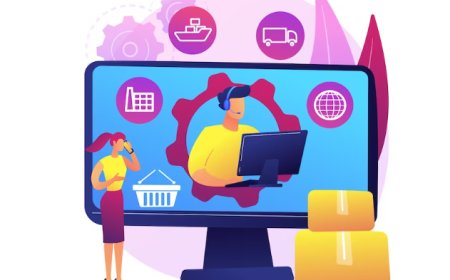Exploring Python GUI Programming: Creating User-Friendly Applications
Explore the world of Python GUI programming and learn how to create user-friendly applications

The Role of graphical user interfaces (GUIs) has emerged as pivotal. GUIs are the essential conduits bridging the divide between human users and the intricate machinery of software. They provide an immersive, visual, and interactive means through which individuals interact with applications, software, and digital systems. GUIs have transcended being a mere convenience; they've become the norm, deeply integrated into almost every domain of computing, from the palm-sized screens of mobile apps and web interfaces to the expansive realms of desktop software.
From the user's perspective, GUIs offer a transformative experience. They empower individuals to navigate complex software and access a myriad of features with ease. Users can seamlessly input data, retrieve information, and perform actions through the familiar elements of buttons, menus, and graphical representations. GUIs have not only democratized access to technology but have also raised the bar for user expectations, driving software developers to create interfaces that are not just functional but aesthetically pleasing and user-friendly.
Python's Ascension in GUI Development
At the heart of this GUI revolution, Python, a versatile, high-level programming language, has taken center stage. Python's ascendancy as a prominent choice for GUI development is rooted in its unique combination of features and qualities. It stands out for its simplicity, readability, and extensive standard library that empowers developers to craft intuitive and efficient interfaces.
One of Python's most remarkable traits is its emphasis on user-friendliness. Its clean and elegant syntax serves as a linguistic bridge, making code more human-readable and understandable. This feature significantly eases the development process, ensuring that developers can translate their ideas into functional GUIs with relative ease. Python's adherence to the "Zen of Python," a collection of guiding aphorisms for writing computer programs in Python, further underscores its commitment to creating software that is not just correct, but also user-friendly.
Python's exceptional balance between functionality and user-friendliness has made it the preferred choice for developers who are determined to deliver applications that not only operate flawlessly but are also visually appealing and intuitive. In a world where user experience is paramount, Python stands as a language that empowers developers to craft GUIs that meet and exceed user expectations. Its clean syntax and extensive libraries provide an excellent platform for creating user-friendly interfaces, making Python a go-to choice in the realm of GUI development. With Python, the focus shifts from writing convoluted code to creating captivating, user-centric interfaces that enhance the way individuals interact with technology. This ascendancy of Python in GUI development is not merely a trend; it's a testament to the language's capacity to elevate the user experience in software applications.
The Challenges of Python GUI Programming
In the ever-expanding realm of software development, Python has garnered well-deserved recognition as an ideal choice for crafting graphical user interfaces (GUIs). Its clean syntax, extensive library support, and user-centric design philosophy make it a natural fit for developers looking to create user-friendly applications. However, as with any creative endeavor, Python GUI programming is not without its set of challenges. Let's delve into the complexities that developers may encounter on their journey to master GUI programming with Python.
1. Striking the Balance Between Art and Science
Python GUI programming requires a unique blend of artistic design sensibilities and technical expertise. Crafting a visually appealing interface is not solely about arranging buttons and colors but also about understanding user psychology and ergonomics. It entails knowing where to place elements for maximum user convenience and how to create an intuitive flow within the application. Achieving this balance between art and science can be a formidable challenge, especially for developers who are predominantly focused on code and logic.
2. The Intuitive Conundrum
User-friendly interfaces must be intuitive. Users should be able to interact with an application without needing a manual. Achieving this level of intuitiveness can be tricky. It necessitates empathizing with the end-user, understanding their thought processes, and predicting their actions. Striking a balance between functionality and simplicity is a constant challenge. Developers often grapple with decisions about which features to expose prominently and which to tuck away, ensuring that users can access them effortlessly when needed.
3. Ensuring Functionality and Responsiveness
A GUI isn't just about appearance; it's about functionality and responsiveness. An aesthetically pleasing interface loses its appeal if it doesn't respond promptly to user input or lacks the functionality users expect. Ensuring that every button, form, or widget performs as intended and that the application runs smoothly under various conditions requires rigorous testing and optimization.
4. Handling Compatibility and Portability
Python GUI applications need to run on diverse platforms and devices. Ensuring compatibility and portability can be a significant challenge. Developers must consider how the application will scale from large desktop screens to small mobile displays, how it will function on different operating systems, and how it will adapt to various input methods (e.g., touch, mouse, or keyboard).
5. Threading and Concurrency
GUI applications often need to handle concurrent tasks, such as responding to user input while performing background operations. Managing threads and concurrency can be complex, especially for developers new to Python's threading model. Ensuring that the GUI remains responsive while background tasks execute smoothly requires a deep understanding of threading principles.
6. The Learning Curve of GUI Frameworks
Python offers various GUI frameworks, each with its own learning curve. For newcomers, selecting the right framework and understanding its intricacies can be a daunting task. Frameworks like PyQt, Tkinter, Kivy, and, as mentioned earlier, Pyramid for web-based GUIs, come with their unique features and methodologies. Learning to navigate these frameworks efficiently takes time and effort.
7. User Testing and Feedback Integration
Creating user-friendly GUIs necessitates gathering user feedback and conducting testing. Incorporating feedback into design iterations and ensuring that the final product aligns with user expectations is an ongoing challenge. User feedback can reveal design flaws or usability issues that require refinement.
Can Python be Effectively Harnessed for GUI Development ?
Python's adaptability and extensive libraries make it a powerful tool for GUI development. Harnessing Python's potential to create user-friendly and aesthetically pleasing GUI applications is indeed achievable. Developers can do so by employing the right strategies, tools, and best practices to ensure that Python-based GUIs excel in both functionality and design.
-
Strategies for Harnessing Python for GUI Development:
-
Leverage Python's clean and readable syntax to streamline development.
-
Choose an appropriate GUI framework (e.g., Tkinter, PyQt, Kivy) that aligns with project requirements.
-
Emphasize user-centered design principles to create intuitive interfaces.
-
Exploit Python's extensive standard library for added functionality.
-
Tools for Effective Python GUI Development:
-
Utilize GUI design tools like Qt Designer or Glade to create visual layouts.
-
Implement version control systems (e.g., Git) for collaboration and code management.
-
Leverage IDEs (e.g., PyCharm) with GUI development support for enhanced productivity.
-
Best Practices for Successful Python GUI Applications:
-
Prioritize responsive design for adaptability across various devices and screen sizes.
-
Conduct user testing and incorporate feedback iteratively to enhance user experience.
-
Optimize code for performance and responsiveness.
-
Ensure cross-platform compatibility for wider reach.
Crucial Steps and Best Practices for Creating User-Friendly GUI Applications Using Python
In the realm of GUI development, creating user-friendly applications involves a series of crucial steps and adherence to best practices. Developers should be aware of these key insights and recommendations to successfully navigate the journey of developing user-friendly GUIs using Python.
-
Setting Up a Development Environment:
-
Create isolated Python environments using virtual environments for project organization.
-
Install the required GUI framework (e.g., Tkinter, PyQt, Kivy) and other dependencies using package managers like pip.
-
Creating User-Friendly Interfaces:
-
Prioritize intuitive and responsive design by placing interactive elements strategically.
-
Use GUI design tools to create visually appealing layouts.
-
Maintain consistency in design elements, such as colors, fonts, and layout.
-
Handling User Input Effectively:
-
Implement error handling and validation to provide user-friendly feedback.
-
Design forms and input fields for clarity and ease of use.
-
Consider input methods like touch, mouse, and keyboard for versatility.
-
Securing Applications:
-
Implement user authentication and authorization mechanisms to safeguard user data.
-
Encrypt sensitive information to protect against data breaches.
-
Regularly update security measures to stay ahead of potential threats.
-
Testing Thoroughly:
-
Conduct rigorous testing to identify and rectify issues, focusing on functionality, usability, and performance.
-
Perform usability testing with real users to gather feedback.
-
Automate testing processes to streamline quality assurance.
-
Deploying Applications:
-
Choose an appropriate deployment method, considering web servers, app stores, or cloud platforms.
-
Ensure that deployment is seamless and user-friendly.
-
Monitor application performance post-deployment and make necessary optimizations.
-
Scaling for Growing User Bases:
-
Plan for scalability by optimizing code, databases, and infrastructure.
-
Implement load balancing and caching mechanisms to handle increased traffic.
-
Regularly update and maintain the application to accommodate user growth.
The Art of Python GUI Programming
In this section, we explore the domain of Python GUI programming, uncovering why Python is an excellent option for crafting Graphical User Interfaces (GUIs). With its clear and easily understandable code, Python distinguishes itself. Its wide range of libraries and robust community backing ensure that GUI development is smooth and approachable. Moreover, we'll introduce you to the Pyramid framework, a versatile resource for constructing GUIs that seamlessly meshes with Python.
Setting Up Your Development Environment
Setting up your development environment is the first step in your GUI programming journey. Learn how to establish isolated Python environments using virtual environments, ensuring project stability and efficient package management. We'll guide you through the safe installation of Pyramid and other essential tools using Python's package manager, pip.
Creating a Simple GUI Application
In this chapter, you'll kickstart your GUI project using the Pyramid framework. We'll show you how to initiate your projects, configure essential settings, and define project structures. You'll also explore the URL dispatch mechanism in Pyramid, which is key to directing user requests to specific views and actions. Additionally, we'll delve into how Pyramid's templating system, such as Chameleon or Jinja2, empowers developers to create dynamic web pages.
Crafting User-Friendly Interfaces
Creating user-friendly interfaces is more than just aesthetics. This chapter highlights the importance of functionality, intuitiveness, and accessibility. You'll gain insights into incorporating interactive elements like buttons, forms, and dropdowns. Moreover, we'll explore the role of HTML templates and CSS styling in structuring and beautifying your interfaces.
Handling User Input
User input is central to GUI development. Here, you'll learn the best practices for collecting, processing and responding to user input effectively. We'll guide you through implementing forms and utilizing Pyramid's view logic to ensure your application is not only user-friendly but also highly functional.
Data Handling and Storage
Efficient data handling and storage are crucial in many GUI applications. This chapter delves into the integration of Pyramid with databases like SQLAlchemy. You'll learn how to store and retrieve data efficiently, essential for applications involving user accounts, settings, or dynamic content.
Security and Authentication
Security is paramount in GUI applications. In this chapter, you'll discover Pyramid's built-in security features. These features provide robust mechanisms for user authentication and authorization, safeguarding your GUI application and user data.
Delving into Python GUI programming offers a world of possibilities for creating intuitive and user-friendly applications. By leveraging the power of libraries such as Tkinter, PyQt, and wxPython, developers can craft visually appealing interfaces that enhance user interaction and overall experience. Emphasizing responsive design and intuitive navigation further ensures that the applications meet user expectations, leading to increased engagement and satisfaction. As Python continues to solidify its position as a leading programming language, mastering GUI development can open up new avenues for building robust and user-centric applications.





































